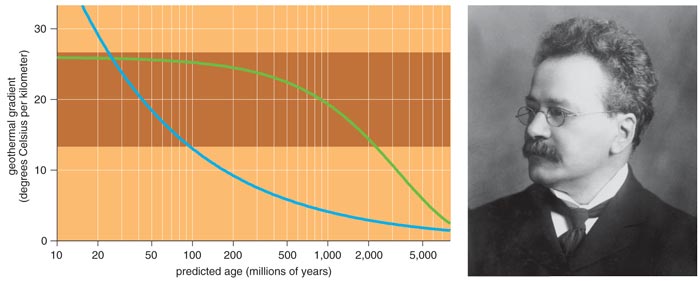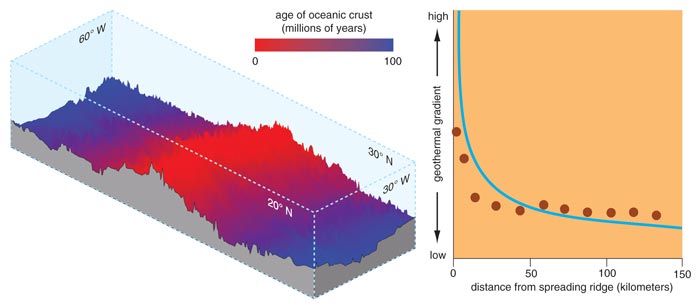Kelvin, Perry and the Age of the Earth
By Philip C. England, Peter Molnar, Frank M. Richter
Had scientists better appreciated one of Kelvin's contemporary critics, the theory of continental drift might have been accepted decades earlier
Had scientists better appreciated one of Kelvin's contemporary critics, the theory of continental drift might have been accepted decades earlier

DOI: 10.1511/2007.66.342
The 19th-century scientific community grappled at length with the question of the age of the Earth, a subject for which a definitive answer did not arrive until the refinement of radiometric dating in the mid-20th century. The most famous—and famously wrong—estimation of the Victorian era came from the renowned physicist William Thomson (1824-1907), known from 1892 as Lord Kelvin.

Image courtesy of Shuo Wang, University of Minnesota.
The story of Kelvin and the age of the Earth is often told as a David-and-Goliath struggle, with geologists playing the role of underdog, armed only with the slender sword of geological reasoning, while Lord Kelvin bludgeoned them with the full force and prestige of mathematical physics. Kelvin's eventual comeuppance is often taken as evidence that simple physics ought not to be applied to complex geological problems. But there are many simple physical models that have had great explanatory power in geology.
Many people believe that Kelvin's calculation failed through his ignorance of radioactivity. Here, we examine Kelvin's approach and show that this was not where his error lay. The flaw in Kelvin's thinking was divined by one of his own assistants, a scholar, educator and inventor named John Perry, who attempted and failed to convince the establishment of the day that enhanced heat transfer in the Earth's interior—by convection or some other means—could reconcile the geological and the physical arguments. Today it is possible to see how Perry's ideas could have advanced the study of the Earth considerably, had geologists understood and appreciated them.
The French mathematician Joseph Fourier (1768-1830) laid the quantitative groundwork for Kelvin's estimation of the age of the Earth in an 1822 treatise titled Théorie Analytique de la Chaleur (Analytic Theory of Heat). Kelvin began writing on this subject when he was 16, clarifying some of Fourier's mathematics, and he first addressed the age of the Earth in 1844, when he showed that measurement of the rate of heat loss from the planet's surface could place limits on its age.

Graph at left by Dave Schneider. Photograph at right from Burndy Library, courtesy of AIP Emilio Segrè Visual Archives.
Kelvin imagined the Earth to have solidified from an originally molten state, such that its initial condition was of uniformly high temperature throughout, with its surface maintained at some constant temperature thereafter. Under these assumptions, temperature depends on the depth below the Earth's surface and on the time that has elapsed since the initial state existed.
To get a feel for the physics at hand, one can carry out a simple thought experiment. Imagine what would happen if you took a Thanksgiving turkey piping hot from the oven and immediately placed it in a freezer. (Consider a perfect freezer—one that can remove heat instantly and always stay at its set temperature.) Initially, the turkey would be at the same temperature throughout (assuming that you had roasted it for sufficiently long). Only a very thin skin would immediately take on the temperature of the freezer. But soon, the outer layers of turkey meat would cool as heat diffused outward, even though the center retained its initial oven-like temperature. Eventually, of course, everything including the stuffing would cool off; that is, the temperature inside your turkey would depend both on the distance from the surface and on the time elapsed since you placed it in the freezer.
Kelvin's analysis allows one to put numbers to this thought experiment. The rate of flow of heat through a surface is proportional to the gradient (or spatial derivative) of the temperature. Fourier had shown that temperature changes within a solid obey the diffusion equation, in which the rate of change of temperature at a point is proportional to the second spatial derivative of the temperature (the curvature of the line on a temperature-distance plot), with the constant of proportionality being a property of the material called thermal diffusivity. The essential feature of all solutions to the diffusion equation is that the length of time required for heat to travel a given distance is proportional to the square of that distance divided by the thermal diffusivity. For example, 5 minutes after you place the bird in your freezer, only a thin layer of meat, about 1 centimeter thick, will have felt any effect of the cold surroundings; anything deeper than this will still be at the roasting temperature. But while it takes about 5 minutes to conduct away the heat from the top 1 centimeter of a turkey, it takes 20 minutes to mine the heat from the outermost 2 centimeters. (This simple physical principle underlies the advice given in many cookbooks that one should take the turkey out of the oven as much as an hour before carving it, because its interior will continue to cook, without the exterior's drying out.)
For the sake of having concrete numbers to use in this thought experiment, assume a temperature difference of 200 degrees Celsius between the interior of the oven and the interior of the freezer; 180 degrees is a pretty good temperature for roasting turkeys, and -20 degrees is a pretty good temperature for freezing ice cream. Five minutes after the start of the experiment, the outer 1 centimeter of turkey has cooled, and the gradient in temperature with depth is 20 degrees per millimeter of turkey. After 20 minutes, 2 centimeters have cooled, and the gradient is 10 degrees per millimeter of turkey. Another way of putting this relation is to say that the thermal gradient is inversely proportional to the square root of the time since the turkey was put in the freezer.
By inverting—or turning inside out—Fourier's diffusion calculation, Kelvin could solve for the age of the Earth in terms of the geothermal gradient at the surface. To pursue the analogy, if you found that a Thanksgiving turkey mysteriously appeared in your freezer, you could determine how long ago someone had put it there by measuring the temperature gradient at its surface. A temperature gradient of 5 degrees per millimeter would, for example, imply an "age" of 80 minutes. (There is a parallel here, familiar to devotees of detective fiction, with the measurement of a corpse's temperature to determine the time of death.)
"You can understand the physicists' reasoning perfectly if you give your mind to it."
When Kelvin first made these arguments (though more formally) in 1844 and 1846, he had no reliable measurements of geothermal gradient, but by the time he returned to the problem 15 years later, geothermal gradients had been measured in several parts of the world. Kelvin quoted temperature increases of between 1/110th and 1/15th of a degree Fahrenheit for each foot of depth in the Earth. He chose the mean gradient in his calculation to be 1/50th of a degree Fahrenheit per foot (or about 36 degrees Celsius per kilometer). He estimated Earth's initial temperature (7,000 degrees Fahrenheit, or 3,900 degrees C) from melting experiments on rocks, and laboratory measurements gave him values for the thermal diffusivity of typical crustal materials. Inserting the observed quantities into his calculations gave Kelvin an age for the Earth of between 24 million and 400 million years, with the range reflecting the uncertainties in the values of the geothermal gradient and thermal conductivity.
Scientists derive an extra measure of confidence in a conclusion if they can arrive at it by more than one independent route, and this was no doubt true for Kelvin, who looked also at the age of the Sun. Given what was known at the time, the only plausible source for the energy radiated by the Sun was internal, derived from the gravitational potential energy released during its accretion. Kelvin had calculated the amount of this energy and concluded that the Sun could sustain its present rate of radiation for no more than 100 million years. The agreement with his independently derived age of the Earth undoubtedly strengthened Kelvin's confidence in his result, and though he later reduced his estimate to about 20 million years, he never swerved from his conviction that the Earth's age was a few tens or hundreds of millions of years, no more.
Geologists now know that the Earth is some 4.5 billion years old. Where did Kelvin go wrong? Did he use erroneous values for the geothermal gradient, for the thermal diffusivity of rocks or for the initial temperature of Earth? None of these. If one were to take advantage of today's best understanding of these parameters, repeating Kelvin's calculation would still give an age between 24 million and 96 million years.
Before dissecting Kelvin's arguments, it is worth describing the worldview that he was opposing. Early 19th-century geologists largely accepted the doctrine that the Earth was of unlimited age, reflecting an aphorism of the 18th-century Scottish geologist James Hutton: that the geological record showed "no vestige of a beginning, no prospect of an end." This doctrine allowed geologists to explain any phenomenon not by the laws of physics, but by what the American geologist and educator Thomas Chrowder Chamberlin in 1899 referred to as "reckless drafts on the bank of time." For Kelvin, this game without rules was simply not scientific. Indeed, it was forbidden by the laws of thermodynamics, which he had played a large part in developing.
In 1867, Kelvin had a telling exchange with the Scottish geologist Andrew Ramsay after a lecture on the geological history of Scotland. Kelvin relates:
I asked Ramsay how long a time he allowed for that history. He answered that he could suggest no limit to it. I said "You don't suppose geological history has run through 1,000,000,000 years?" "Certainly I do." "10,000,000,000 years?" "Yes." "The sun is a finite body. You can tell how many tons it is. Do you think it has been shining for a million million years?" "I am as incapable of estimating and understanding the reasons which you physicists have for limiting geological time as you are incapable of understanding the geological reasons for our unlimited estimates." I answered, "You can understand the physicists' reasoning perfectly if you give your mind to it."
It is easy to overlook the enormous gains to geology that came simply from having to fight the battle with Kelvin about the age of the Earth. By the end of the 19th century, the doctrine of a steady-state Earth of indefinite age had given way to a more sophisticated view: Geologists had come to accept that the age of the Earth was finite and that estimating its value by quantitative reasoning was a crucial part of geological endeavor. What nobody did until 1895, however, was to put their mind, as Kelvin had suggested, to his reasoning.
A single principle underlies all Kelvin's arguments about the age of the Earth—that energy is conserved. To carry out his analyses, Kelvin added three assumptions, two of which applied only to his arguments about the Earth: that the planet is rigid and that its physical properties are homogeneous. The third assumption, that there was no undiscovered source of energy, applied both to the Earth and to the Sun. We now know that the third assumption explains Kelvin's error about the age of the Sun; the energy radiated by the Sun is generated by the fusion of hydrogen into helium in its interior, although quantitative demonstration that this is so had to await the detection of the "missing neutrinos" in 2001.
The conventional story has it that Kelvin's third assumption was also his undoing in calculating the age of the Earth. Although it is true that the decay of radioactive elements inside the Earth provides a long-lived source of heat, ignorance of this energy source was not responsible for Kelvin's incorrect estimate for the age of the Earth. The real mistake in his argument was pointed out by one of his former assistants, John Perry, almost a decade before radioactivity became recognized as a source of heat.

Graph at left by Barbara Aulicino. Photograph at right by Science Museum Pictorial.
Perry, a northern Irishman, attended Queen's University in Belfast, where he received lectures in engineering from Kelvin's brother James, who was also a notable scientist. After graduating, Perry spent four years as a schoolteacher before going to work as Kelvin's assistant in Glasgow. He remembered Kelvin with affection and respect all his life, not least—it seems likely—because Kelvin transformed the young Perry's career. Within a year, the schoolteacher had become a professor of engineering in Tokyo, where he contributed greatly to the birth of Japanese industry, before returning to a professorship in London.
In both Tokyo and London, Perry was a tireless educator in engineering and mathematics, insisting that mathematics should be presented to scientists in a clear and concrete fashion. Generations of schoolchildren, all unknowing, were influenced by him because he recognized the enormous power of graph paper in the plotting of functions and data and, by driving down its price of production, ensured that it entered into common use. He ended his career as Professor of Engineering at the Royal College of Science (the present Imperial College London).
Perry discovered the flaw in Kelvin's argument in 1894 but, reluctant to embarrass his patron, tried first to convince Kelvin face to face and by private correspondence. He was brushed off, either because Kelvin did not understand Perry's approach or because he was not interested. In 1895, therefore, Perry decided to go public, and he wrote to the journal Nature: "I have sometimes been asked by friends interested in geology to criticize Lord Kelvin's calculation of the probable age of the earth. I have usually said that it is hopeless to expect that Lord Kelvin should have made an error in calculation." Instead of focusing on Kelvin's math, Perry suggested that one should examine his assumptions.
In Kelvin's model, the thermal gradient near the surface of the Earth (or, in the thought experiment given above, of the turkey) drops as the cooled outer skin thickens with age. If the Earth were much older than about 100 million years, this skin would be so thick that the thermal gradient would be much lower than is observed. Perry realized that there is a simple way to stop the skin from thickening: He proposed that heat might be transferred much more efficiently in the interior of the Earth than at the surface. If this were so, the deep interior could provide a large store of heat, which would keep the surface temperature gradient high for a long time, and Kelvin's estimate of the age of the Earth would be too low, potentially by a large multiple.
"... as I came to the important point, I saw the old bird sit up, open an eye and cock a baleful glance at me!"
Perry had various suggestions as to how this might happen, but, for our purposes, his most important argument was that convection in the fluid, or partly fluid, interior of the Earth could transfer heat much more effectively than does diffusion. He pointed out that if only a thin outer skin of the planet is solid and if the rest of the Earth is a convecting fluid, then the interior would be well mixed and at the same temperature throughout. Perry's model thus replaces the thought-experiment turkey with a turkey-sized bottle of, say, hot cider. Only the outer few millimeters of this object are solid (the glass of the bottle), and convection churns the interior. Thus the temperature gradient at the surface can stay high for a very long time.
Perry's calculation shows that if the Earth has a conducting lid of 50 kilometers' thickness, with a perfectly convecting fluid underneath, then the measured thermal gradients near the surface are consistent with any age up to 2 billion or 3 billion years. Recognizing that heat transfer in the mantle cannot be perfectly efficient, Perry subsequently modeled the deep interior as a solid with high "quasi-diffusivity." His results agreed with the original simple calculation in suggesting that the Earth could be several billions of years old. Full calculations of convection in the mantle (which were impossible until the advent of computers) confirm that Perry's reasoning was sound.
In other words, Perry was able to reconcile a physical calculation of Earth's thermal evolution with the great age that geologists required. Perry needed nothing more than to introduce the idea that heat moved in the deep interior of the Earth more readily than it moved in the outermost layers. Yet to this day, most geologists believe that Kelvin's (understandable) mistake was not to have known about Earth's internal radioactivity.
In 1903, Pierre Curie and his assistant Albert Laborde determined that the newly discovered process of radioactive decay releases heat, and several people soon argued that this source was great enough to overturn Kelvin's conclusion about the age of the Earth. In particular, Ernest Rutherford, who is considered the father of nuclear theory, spoke on the matter at a meeting at the Royal Institution in 1904:
I came into the room, which was half dark, and presently spotted Lord Kelvin in the audience and realized that I was in for trouble at the last part of the speech dealing with the age of the earth, where my views conflicted with his. To my relief he fell fast asleep but as I came to the important point, I saw the old bird sit up, open an eye and cock a baleful glance at me! Then sudden inspiration came, and I said Lord Kelvin had limited the age of the earth, provided no new source of heat was discovered. That prophetic utterance refers to what we are now considering tonight, radium! Behold! The old boy beamed at me.

Photograph at left by Ramsay and Muspratt, courtesy of AIP Emilio Segrè Visual Archives, Brittle Books Collection. Graph at right by Barbara Aulicino.
Perhaps the fame of this anecdote explains the still-common statement that the discovery of radioactive heat undermined both an assumption behind Kelvin's calculation and its conclusion. But that assertion is logically incorrect. Kelvin's conclusion would have been invalidated by the discovery of radioactive heat only if incorporation of that heat into his calculation were to produce a substantially different age for the Earth.
"I know that solid rock is not like cobbler's wax, but 109 years is a long time, and the forces are great!"
The modern estimate for the total rate of radioactive heat generation within the Earth is about 2 x 1013 watts, equivalent to about half the total amount of heat flowing out of the planet at present. It might, therefore, seem that Earth's internal heat production can make a sizable contribution to temperature gradients at the surface. One must recall, however, that this heat production is distributed through the whole volume of the 2,900-kilometer-thick mantle and that Kelvin's calculation showed that diffusion can mine the heat from only the outer 100 kilometers of the Earth in 100 million years. One should correspondingly expect that if Kelvin's calculation were re-run with the inclusion of radioactivity, only the heat generated in the outermost 100 kilometers of the Earth (about 5 percent of the volume of the mantle) would contribute to the temperature gradient at the surface. Hence, even if Kelvin had included radioactive heat in his calculation, his estimate of the age of the Earth would have been virtually unaffected. A careful calculation that takes account of the details of the distribution of radioactive heating validates this simple argument.
Perry's analysis of the age of the Earth followed Kelvin's lead, in that he insisted on analysis of a simple physical system—but the system he chose to analyze was different from Kelvin's. A fluid mantle was widely understood as the necessary condition for isostasy: the idea (worked out earlier in the 19th century) that crustal features such as mountain ranges must float on the denser mantle, in the same way that icebergs float on water. Yet Kelvin felt that he was on firm ground in rejecting the notion of a fluid interior: He knew from the study of Earth tides that at least the outer 1,500 kilometers of the mantle are as rigid as steel. Perry tried hard to change Kelvin's mind on this point, using language specifically addressed to Kelvin's way of thinking. He wrote:
… the real basis of your calculation is your assumption that a solid earth cannot alter its shape … even in 1000 million years, under the action of forces constantly tending to alter its shape, and yet we see the gradual closing up of passages in a mine, and we know that wrinkling and faults and other changes of shape are always going on in the solid earth under the action of long-continued forces. I know that solid rock is not like cobbler's wax, but 109 years is a long time, and the forces are great!
Perry's reference to cobbler's wax was deliberate and requires some explanation. Kelvin, like many physicists at the time, thought that light could not travel in a vacuum but required a physical medium, the "ether," for propagation. That medium had to possess elastic properties at very short times to allow light waves to propagate, but it needed to be weak at longer time scales so that the Earth could move freely through it.
Although he could not find a satisfactory mathematical formulation for the ether, Kelvin was fond of a physical demonstration that illustrated its required physical properties. He placed water in a glass cylinder, floated a number of small corks on the surface, covered them with a layer of Scottish shoemaker's wax and finally placed bullets on the top. Over a short period of observation, nothing visible happened, but after six months the corks and the bullets had embedded themselves within the wax. After a year, the corks could be found on the top and the bullets on the bottom. The wax exhibits strength in the short term but is weak on long time scales.
These properties, qualitatively, were exactly those that Kelvin required of the ether. Perry was arguing that the disagreement between Kelvin and the geologists could be resolved if it were accepted that the mantle of the Earth is rigid at short times but fluid over longer time scales. Kelvin completely missed the point, and so, it seems, did everyone else.
Perry published his arguments in the pages of Nature, which was as prominent an organ of scientific discourse in 1895 as it is today. Others concerned with the debate about the age of the Earth certainly knew of Perry's challenge to Kelvin's conclusions. So why was Perry's recognition of convection in the Earth's interior not accepted in the decade before radioactive heat became established—or indeed, thereafter?
Personal factors were probably important. Most modern scientists, if they were as convinced as Perry was about a major topic of debate, would have pushed harder. Perry revered Kelvin and, although he felt strongly that an alternative physical argument should be put forward, he was not the sort of person to indulge in egotistical disputation. He seems not to have pursued this topic but to have spent another 25 years researching and teaching on the wide range of subjects that interested him, eventually succumbing to scurvy contracted on a long sea voyage taken for his health.
Perry was not alone in deferring to figures of authority in a way that is uncommon today. Perhaps a similar atmosphere of deference allowed Kelvin's assessment of the situation to be supplanted by Rutherford's after 1904.
The neglect of Perry's argument may also be explained by the fact that it was not understood by most people who cared about the age of the Earth. Biologists seized on Perry's conclusion that Kelvin's estimate could be wrong, while at the same time freely admitting that they couldn't understand his argument. The geological community was happy to take the demonstration that Kelvin was wrong as evidence that geological intuition trumps simple physical analysis as far as the "real" Earth is concerned. (One should not forget, though, that the geologists of the time produced estimates for the age of the Earth which were just as wrong as Kelvin's—often more so.)
Many geologists felt, as Andrew Ramsay's tart conversation with Kelvin suggested, that physicists were incapable of understanding geological reasoning and that geology is too complex to be encapsulated in a mathematical model. Perry's analysis shows, however, that Kelvin's failure lay not in the use of simple physics, but in using the wrong simple physics.
Both Kelvin and Perry knew that simple models—the purpose of which is to allow analysis of the major features of phenomena, not slavishly to reproduce all their details—are indispensable tools in science. Many of the most useful models are underlain by a principle Einstein famously expressed: "Everything should be made as simple as possible, but not simpler."

Figure at left by Dave Schneider and Barbara Aulicino. Graph at right adapted by Dave Schneider from Sclater et al. 1980.
It is worth illustrating the explanatory power of simple models in geology with a relevant modern example. Suppose one wished to explain the thermal evolution of the ocean floor. A model that accounted accurately for major, obvious variables (different thermal properties and thicknesses of the various geological layers, the heat-driven circulation of water through the shallower portions of this rock, seafloor volcanism and so forth) would still have at least a dozen parameters, many of them poorly known, and would require millions of calculations simply to explore the many possibilities. Consequently, the results of such a model would be impossible to grasp.
In contrast, treating the ocean floor as a homogeneous slab of rocky material yields Kelvin's simple analytical solution for a cooling "half-space," which captures the main features of oceanic plates as they move away from the volcanic ridges where they form. And by including the thermal contraction that takes place as the slab cools, such a model neatly explains the measured depth of most of the seafloor.
What Kelvin did not allow for is that, to varying degrees, all simple models are bound to break down, and scientists may learn as much by their failures as by their successes. The cooling-half-space model fails for young ocean floor because heat is also carried through oceanic ridges by the circulation of hot water. However, the degree to which thermal gradients depart from the prediction of the simple model allows geophysicists to estimate the amount of heat transferred by that circulation and hence to determine the flux of water through the ridges. The model also fails for ocean floor older than about 80 million or 90 million years, but in doing so it reveals a second scale of convection in the mantle and allows geophysicists to estimate the thickness of tectonic plates.
In a parallel way, Perry's analysis showed that the failure of a conductive model for the Earth could be explained if the mantle were to convect. If the scientific community of the day had absorbed Perry's message, the first radiometric ages for the Earth would have come as confirmation of the convective explanation for the Earth's observed geothermal gradient. The realization that convection takes place within the Earth's apparently solid interior would have made it hard to sustain the "fixist" view of the Earth—which held that it was physically impossible for continents to move horizontally. That perception of fixity exerted a powerful brake on geological progress in the first half of the 20th century: Proponents of continental drift needed repeatedly to make arguments that the solid Earth could flow over long time scales—against considerable skepticism. It took until the 1960s for their views to prevail.
One is left with the question of why many scientists (professional geologists included) continue to believe that the discovery of radioactivity simultaneously proved Kelvin wrong and provided the explanation for his error. Part of the answer, perhaps, is that it makes for a good story. Arthur Eve, one of Rutherford's early biographers, reported that this influential physicist repeated on many occasions his tale of thinking on his feet in front of the "old bird" Kelvin. It is entirely possible that the pleasing form of the anecdote, and the eminence of its author, led to the uncritical acceptance of the myth. It is hard to dissuade aging scientists, as they slip into their anecdotage, from repeating stories that they find amusing. But their younger colleagues must be careful not to mistake such accounts for history.
Click "American Scientist" to access home page
American Scientist Comments and Discussion
To discuss our articles or comment on them, please share them and tag American Scientist on social media platforms. Here are links to our profiles on Twitter, Facebook, and LinkedIn.
If we re-share your post, we will moderate comments/discussion following our comments policy.